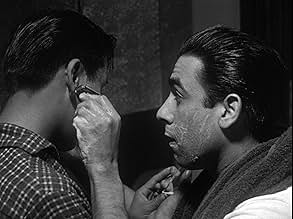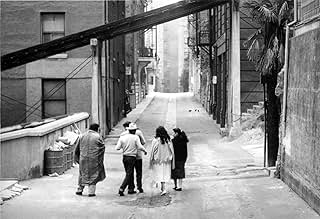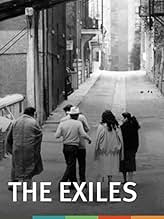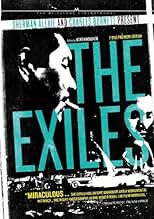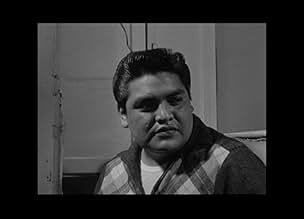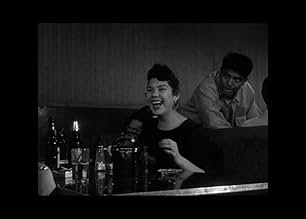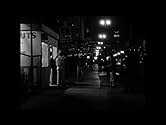VALUTAZIONE IMDb
6,6/10
1512
LA TUA VALUTAZIONE
Aggiungi una trama nella tua linguaFollows a family of Native Americans living in the City of Angels.Follows a family of Native Americans living in the City of Angels.Follows a family of Native Americans living in the City of Angels.
- Regia
- Sceneggiatura
- Star
- Premi
- 1 vittoria in totale
Tom Reynolds
- Tommy
- (as Tommy Reynolds)
Recensioni in evidenza
This was one of the first films to deal with the contemporary lives of Native Americans. It's still one of the very few pieces to deal with the Native urban diaspora, in this case in the no-longer existing LA neighborhood of Bunker Hill, in 1961.
More broadly, "Exiles" is a film about displacement, and finding oneself in a state of displacement, of having one's truest self be the displaced self. It focuses on a young, married couple who hardly see each other. The husband is out cavorting and fighting with other young quasi- hooligans. The wife is mostly alone, or abandoned at the cinema. The only scene where we sense that she is bonding with anybody is when she is in bed, in an officially asexual way, with a girlfriend.
As an empathetic depiction of the alienation that occurs when people are divorced from their (essentially extinct) culture, one cannot help but admire the film. Yet, I was left with the troubling sense that its depiction of characters driven to cling to each other based on the most basic similarities, such as tribe,race, and, perhaps most importantly in the eyes of the filmmakers, gender, was decidedly heteronormative. I wouldn't go so far as to call the film homophobic. The only brazenly gay characters, a couple of dudes dancing in a "straight" bar, are depicted in a neutral light. Yet, the isolation of man from woman, and "debauched" same-sex mingling are depicted as the prime symptoms of alienation under colonialism and capitalism. This attitude was all too common amid leftists in the era that the film was made.
For contemporary viewers, perhaps the most rewarding thing about The Exiles is its luscious black and white cinematography of the now destroyed Bunker Hill district of Los Angeles. As a documentary extra on the DVD further attests, Bunker Hill was a dynamic, multinational district that was home to immigrant families and retired professionals. Soon after this movie was completed, the neighborhood was bulldozed in an attempt to "improve" LA. In this way, the film seems like a depiction of two fallen cultures: the exiles of crushed Native American culture inhabiting an urban landscape that is itself now only a celluloid ghost.
More broadly, "Exiles" is a film about displacement, and finding oneself in a state of displacement, of having one's truest self be the displaced self. It focuses on a young, married couple who hardly see each other. The husband is out cavorting and fighting with other young quasi- hooligans. The wife is mostly alone, or abandoned at the cinema. The only scene where we sense that she is bonding with anybody is when she is in bed, in an officially asexual way, with a girlfriend.
As an empathetic depiction of the alienation that occurs when people are divorced from their (essentially extinct) culture, one cannot help but admire the film. Yet, I was left with the troubling sense that its depiction of characters driven to cling to each other based on the most basic similarities, such as tribe,race, and, perhaps most importantly in the eyes of the filmmakers, gender, was decidedly heteronormative. I wouldn't go so far as to call the film homophobic. The only brazenly gay characters, a couple of dudes dancing in a "straight" bar, are depicted in a neutral light. Yet, the isolation of man from woman, and "debauched" same-sex mingling are depicted as the prime symptoms of alienation under colonialism and capitalism. This attitude was all too common amid leftists in the era that the film was made.
For contemporary viewers, perhaps the most rewarding thing about The Exiles is its luscious black and white cinematography of the now destroyed Bunker Hill district of Los Angeles. As a documentary extra on the DVD further attests, Bunker Hill was a dynamic, multinational district that was home to immigrant families and retired professionals. Soon after this movie was completed, the neighborhood was bulldozed in an attempt to "improve" LA. In this way, the film seems like a depiction of two fallen cultures: the exiles of crushed Native American culture inhabiting an urban landscape that is itself now only a celluloid ghost.
The premise is simple-we follow a group of young, modern day Native American men and women in Los Angeles over 24 hours. We experience their daily rituals, conflicts, and pleasures, and, for the most part, I found this rather simple film to be highly interesting. Although it remains virtually plot less throughout, there are some moments of conflict and surprising intensity that save it from being "boring" or overly mundane. The tragedies as well as the comedies of life are explored, as personalities, feelings, and opinions are revealed and studied.
The highlights of the film are the dazzlingly beautiful voice over sequences, in which a random character will voice their perspective on their way of life or their friends or their hopes and aspirations, and so on. They transform the every man into a wise and lovable poet. We understand and learn about our characters more and more not only through their subtle actions, but also their words and ways of communicating.
However, there are moments of boredom here. I think this movie would have worked better as a lengthy short film that would be, say, 35-40 minutes long. That would be perfect. Either that or a little bit more conflict or humor or just flat out interesting events.
The highlights of the film are the dazzlingly beautiful voice over sequences, in which a random character will voice their perspective on their way of life or their friends or their hopes and aspirations, and so on. They transform the every man into a wise and lovable poet. We understand and learn about our characters more and more not only through their subtle actions, but also their words and ways of communicating.
However, there are moments of boredom here. I think this movie would have worked better as a lengthy short film that would be, say, 35-40 minutes long. That would be perfect. Either that or a little bit more conflict or humor or just flat out interesting events.
The Exiles by Kent Mackenzie, USA (Documentary). A 1961 documentary chronicling a day in the life of a group of twenty-something Native Americans who left reservation life in the 1950s to live in LA.
A unique and powerful film, blending storytelling with documentation. Mackenzie constructed a narrative about one day in the life of three main characters - a pregnant young woman (Yvonne), the father (Homer), and a man about town (Tommy). Both men are profound alcoholics, and the woman seems stunned by the circumstances of her life though hopeful for the future of her child.
The film opens with portraits from Edward Sheriff Curtis's monumental North American Indian, which I recommend as a starting place. Mackenzie has a sharp eye for cultural details - check out the Grand Hotel mattress in Yvonne and Homer's apartment, as well as the magazines, comics, advertisements, toys, and street scenes.
The story develops via voiceovers by Yvonne, Homer, and Tommy - and an amazing middle sequence from the rez, with generous doses of native language and music.
This is a must-see movie for anyone interested in social work, indigenous peoples, or the dark side of American culture. Never boring for any viewer.
A unique and powerful film, blending storytelling with documentation. Mackenzie constructed a narrative about one day in the life of three main characters - a pregnant young woman (Yvonne), the father (Homer), and a man about town (Tommy). Both men are profound alcoholics, and the woman seems stunned by the circumstances of her life though hopeful for the future of her child.
The film opens with portraits from Edward Sheriff Curtis's monumental North American Indian, which I recommend as a starting place. Mackenzie has a sharp eye for cultural details - check out the Grand Hotel mattress in Yvonne and Homer's apartment, as well as the magazines, comics, advertisements, toys, and street scenes.
The story develops via voiceovers by Yvonne, Homer, and Tommy - and an amazing middle sequence from the rez, with generous doses of native language and music.
This is a must-see movie for anyone interested in social work, indigenous peoples, or the dark side of American culture. Never boring for any viewer.
This is a film that certainly won't appeal to the average person. However, despite this, it is an interesting and important film. The movie began as a school project at USC and eventually resulted in this small-time picture. It's about a group of displaced American-Indians who are living in Los Angelese. Unfortunately, their sense of purpose and work ethic have become lost in the transition from the reservation. This film documents a 24-hour stretch in their rather purposeless lives. As a piece of history and commentary it's very important stuff, though it's also the type stuff that is dreadfully dry. Seeing people going about their lives as you hear voice-overs and see dialog crudely inserted (it almost never matched the lip movements of the characters and was sloppy) becomes a bit of a drag after a while. A noble fictionalized documentary but one for which you really have to have a lot of patience in order to enjoy.
The main good points I'd like to pass on are for the benefit of those not having seen this movie.The older you are the more you may like seeing this on location film from 1961.Even for someone like me not familiar with the film location there will be things to remember,the cars,advertising,beer bottles,etc.Probably the most important point to the movie is that these Native Americans are in a new enviorment having come from the reservation,something different for that time period.The movie reflects their being between two different worlds. One of my favorite parts is when about three Indians enter a bar and greet many there warmly and one at a time. It's worth it to see the movie for the reasons previously mentioned.That being said I couldn't watch this movie without pondering questions..How much of the movie is reality? How much is drama? Is this a Friday night or every night/morning? Where does the money come from? Are they all from the same tribe? Not trying to pass off myself as a Native American expert/I speak the language but from the ones I've known it seems like at times different tribes don't get along.That's why I was wondering if the large groups in the movie were all from the same tribe.Despite the unanswered questions it's an interesting film.
Lo sapevi?
- QuizKent Mackenzie borrowed equipment from industrial film makers Parthenon Pictures and used the unused "ends" of thousand-foot reels of 35mm film, according to an article in the 12 March 1961 edition of the New York Times.
- BlooperIn a scene where an older man is heard singing and playing an instrument under a tree, he is not doing corresponding actions in a long-shot.
- ConnessioniFeatured in Los Angeles Plays Itself (2003)
I più visti
Accedi per valutare e creare un elenco di titoli salvati per ottenere consigli personalizzati
- How long is The Exiles?Powered by Alexa
Dettagli
- Data di uscita
- Paese di origine
- Sito ufficiale
- Lingua
- Celebre anche come
- Изгнанники
- Luoghi delle riprese
- Vedi altri crediti dell’azienda su IMDbPro
Botteghino
- Budget
- 539 USD (previsto)
- Lordo Stati Uniti e Canada
- 30.945 USD
- Fine settimana di apertura Stati Uniti e Canada
- 8448 USD
- 13 lug 2008
- Lordo in tutto il mondo
- 30.945 USD
- Tempo di esecuzione
- 1h 12min(72 min)
- Colore
- Mix di suoni
- Proporzioni
- 1.37 : 1
Contribuisci a questa pagina
Suggerisci una modifica o aggiungi i contenuti mancanti


